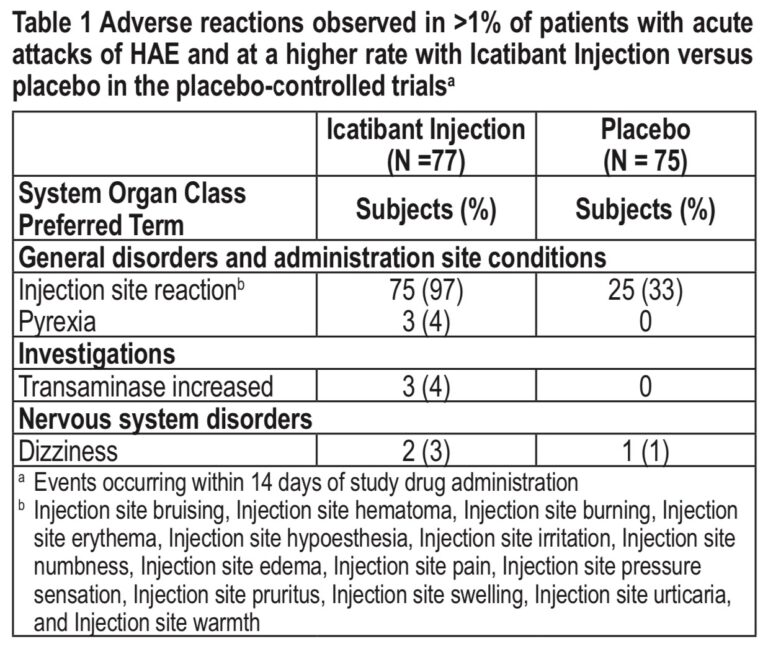Warnings and Precautions
Laryngeal Attacks
Given the potential for airway obstruction during acute laryngeal Hereditary angioedema (HAE) attacks, patients should be advised to seek medical attention in an appropriate healthcare facility immediately in addition to treatment with Icatibant Injection.
Adverse Reactions1
Clinical Trials Experience
The safety of Icatibant Injection was evaluated in three controlled trials that included 223 patients who received Icatibant Injection 30 mg (n=113), placebo (n=75), or comparator (n=38). The mean age at study entry was 38 years (range 18 to 83 years), 64% were female, and 95% were white. The data described below represent adverse reactions observed from the two placebo-controlled trials, consisting of 77 patients who received Icatibant Injection at a dose of 30 mg SC, and 75 who received placebo. The most frequently reported adverse reactions (occurring in greater than 1% of patients and at a higher rate with Icatibant Injection versus placebo) are shown in Table 1 below.
Because clinical trials are conducted under widely varying conditions, adverse reaction rates observed in the clinical trials of a drug cannot be directly compared to rates in the clinical trials of another drug and may not reflect the rates observed in practice.1

Source: Icatibant Injection Prescribing Information. Fresenius Kabi USA, LLC; 2020.
The third trial was active-controlled and was comprised of 35 patients who received icatibant injection 30 mg and 38 patients who received the comparator. Adverse reactions for icatibant injection were similar in nature and frequency to those reported in Table 1.
In all three controlled trials, patients were eligible for treatment of subsequent attacks in an open-label extension. Patients were treated with Icatibant Injection 30 mg and could receive up to 3 doses of Icatibant Injection 30 mg administered at least 6 hours apart for each attack. A total of 225 patients were treated with 1,076 doses of 30 mg Icatibant Injection for 987 attacks of acute HAE. Adverse reactions similar in nature and frequency were observed to those seen in the controlled phase of the trials. Other adverse reactions reported included rash, nausea, and headache in patients exposed to Icatibant Injection.
The safety of self-administration was evaluated in a separate, open-label trial in 56 patients with HAE. In this trial, the safety profile of Icatibant Injection in patients who self-administered Icatibant Injection was similar in nature and frequency to that of patients whose therapy was administered by healthcare professionals.
Postmarketing Experience
The following adverse reactions have been identified during post approval use of Icatibant Injection: urticaria. Because these events are reported voluntarily from a population of uncertain size, it is not always possible to reliably estimate their frequency or establish a causal relationship to drug exposure.
To report SUSPECTED ADVERSE REACTIONS, contact Fresenius Kabi USA, LLC at 1-800-551-7176, option 5, or FDA at 1-800-FDA-1088 or www.fda.gov/medwatch.1
Immunogenicity
Across repeated treatment in the controlled trials, 4 patients tested positive for anti-icatibant antibodies. Three of these patients had subsequent tests which were negative. No hypersensitivity or anaphylactic reactions were reported with Icatibant Injection. No association between anti-icatibant antibodies and efficacy was observed.
Use in Specific Populations
Pregnancy
Available data from published literature and the pharmacovigilance database with Icatibant Injection use in pregnant women have not identified a drug-associated risk of major birth defects, miscarriage, or adverse maternal or fetal outcomes.
Lactation
There are no data on the presence of icatibant in human milk, the effects on the breastfed infant, or the effects on milk production. The development and health benefits of breastfeeding should be considered along with the mother’s clinical need for Icatibant Injection and any potential adverse effects on the breastfed child from Icatibant Injection or from the underlying maternal condition.
Pediatric Use
Safety and effectiveness in pediatric patients below the age of 18 years have not been established.
Geriatric Use
Clinical studies of Icatibant Injection did not include sufficient numbers of subjects aged 65 and over to determine whether they respond differently from younger subjects. Elderly patients are likely to have increased systemic exposure to Icatibant Injection compared to younger (18 to 45 years) patients. Since other reported clinical experience has not identified differences in efficacy and safety between elderly and younger patients, no dose adjustment is recommended.
The Safety Profile does not include all the safety information for Icatibant Injection. Please see full prescribing information for Icatibant Injection.

